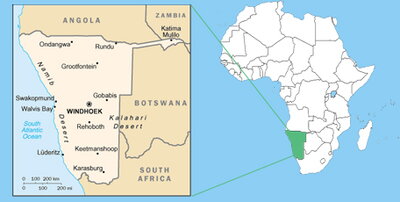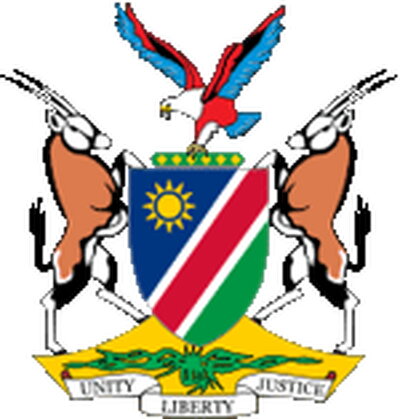

Region: Southern Africa
Quick Facts:
- Population: 2 million
- Capital: Windhoek
- Area: 318,261 sq miles (Slightly less than half the size of Alaska)
- Major Languages: English, Afrikaans, German, Oshivambo, Herero, Nama
- Life Expectancy: 48 years (men), 49 years (women)
- Literacy: 40.1%
- Monetary unit: 1 Nambian Dollar (NAD)=100 cents
- Exchange Rate: US $1= .9.611 NAD (Jan 8, 2009)
- Income (GDP) per capita: $7803 (constant 2000 international $, WDI 2005)
- Urban population: 35% of total population
- Paved roads: 13% of total road surface
- Electric Power Consumption (per capita): 4504 kWH
- Fixed line and mobile phone subscribers: 206 per 1,000 people
- Internet Users: 38 per 1,000 people
- Internet Domain: .na
- Country Code: +264
- Time Difference: UTC+1 (7 hours ahead of Illinois during Standard Time)
- Climate: Semi-arid and subtropical. Hottest months are January and February (63-102F ), coldest months are June and July (43-68F)
- Type of Government: Republic
- President: Hifikepunye Pohamba
Historical Background:
Since early times, Namibia has been inhabited by San, Damara and Namaqua peoples. In about the fourteenth century, immigrating Bantu-speaking groups settled there. The region was not extensively explored by Europeans until the nineteenth century, when the land came under German control.
South Africa occupied the colony during World War I and administered it as an internationally mandated territory until after World War II, when it unilaterally annexed the territory, albeit without international recognition. In 1966, Marxist guerillas launched a war of independence, and Namibia eventually won its freedom in 1988.
Socio-political Background:
Interracial reconciliation after the war of independence encouraged the country’s white population to remain. White Namibians play a vital role in agriculture and other sectors. In recent years, support for land reform has increased. The expropriation of white-owned farms began in 2005 and the government says it plans to resettle thousands of landless citizens on land held by settlers of European ancestory.
Politics of Namibia takes place in a framework of a presidential representative democratic republic, whereby the President of Namibia is both head of state and head of government, and of a pluriform multiparty system. Executive power is exercised by the government. Legislative power is vested in the government and the National Assembly.
Hifikepunye Pohamba, representing the ruling Swapo party, won a landslide victory in presidential elections in November 2004. Opposition parties disputed the outcome and demanded a recount. Most observers said there had been little evidence of irregularities during voting. Mr Pohamba, who was inaugurated in March 2005, said he would pursue his mentor's policies, including proposed land reforms. He has warned of a possible “revolution” should white farmers not agree to sell land to the government.
Like its neighbours, Namibia's wellbeing is being threatened by the HIV/Aids epidemic, which is estimated to affect 15.3% of Namibians. Founding President Sam Nujoma made the fight against the disease a national priority. Diarrhea, hepatitis A, typhoid, malaria are high risk diseases in Namibia.
Economy:
The economy of Namibia is heavily dependent on the extraction and processing of minerals for export. Mining accounts for 20% of GDP. Rich alluvial diamond deposits make Namibia a primary source for gem-quality diamonds. Namibia is the fourth-largest exporter of non-fuel minerals in Africa, the world's fifth-largest producer of uranium, and the producer of large quantities of lead, zinc, tin, silver, and tungsten. The mining sector employs only about 3% of the population while about half of the population depends on subsistence agriculture for its livelihood. Namibia normally imports about 50% of its cereal requirements; in drought years food shortages are a major problem in rural areas. A high per capita GDP, relative to the region, hides the great inequality of income distribution; nearly one-third of Namibians had annual incomes of less than $1400 in constant 1994 dollars, according to a 1993 study. The Namibian economy is closely linked to South Africa with the Namibian dollar pegged to the South African rand. Privatization of several enterprises in coming years may stimulate long-run foreign investment, although with the labor movement opposed, so far most politicians have been reluctant to advance the issue.
The Namibian economy has a modern market sector, which produces most of the country's wealth, and a traditional subsistence sector. Although the majority of the population engages in subsistence agriculture and herding, Namibia has more than 200,000 skilled workers, as well as a small, well-trained professional and managerial class.
The country's sophisticated formal economy is based on capital-intensive industry and farming. However, Namibia's economy is heavily dependent on the earnings generated from primary commodity exports in a few vital sectors, including minerals, especially diamonds, livestock, and fish. Furthermore, the Namibian economy remains integrated with the economy of South Africa, as the bulk of Namibia's imports originate there.
Trade Information:
- Exports: $2.32 billion (2006 est.)
- Export Goods: Diamonds, copper, gold, zinc, lead, uranium; cattle, processed fish, karakul skins
- Main Export Partners (2005): South Africa (33.4%), US (4%)
- Imports: $2.456 billion (2006 est.)
- Import Goods: Foodstuffs, petroleum products, fuel, machinery and equipment, and chemicals
- Main Import Partners (2005): South Africa 85.2%, US
Resources for Businesses:
Embassy of Namibia, Washington, D.C.
1605 New Hampshire Av, NW
Washington, DC 20009
Tel: 202-986-0540
Fax: 202-986-0443
E-Mail: info@namibiaembassyusa.org

Namibia Chamber of Commerce and Industry (NCCI)
PO Box 9355
Windhoek, Namibia
Tel: (264) 61 22 8809
Fax: (264) 61 22 8009
E-Mail: info@ncci.org.na
Ministry of Trade and Industry
Permanent Secretary
Brendan Simbwaye Square, Goethe Street
Private Bag 13340
Windhoek, Namibia
Telephone: (264) 61 283 7332
Fax: (264) 61 220227
Namibia Investment Center
Executive Director
Ministry of Trade and Industry
Brendan Simbwaye Square, Goethe Street
Private Bag 13340
Windhoek, Namibia
Telephone: (264) 61 283 7335
Fax: (264) 61 220278
Email: nic@mti.gov.na
Offshore Development Company
Chief Executive Officer
Brendan Simbwaye Square, Goethe Street
Private Bag 13397
Windhoek
Telephone: (264) 61 283 7360
Fax: (264) 61 231001
Email: odc@mti.gov.na
Last updated on 09/23/2009